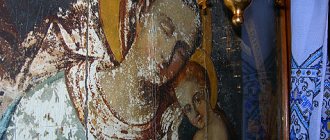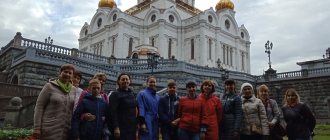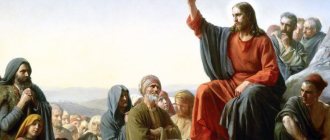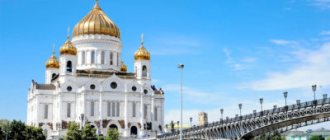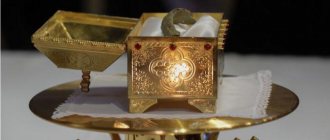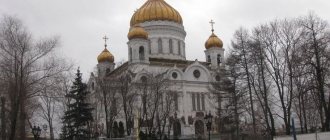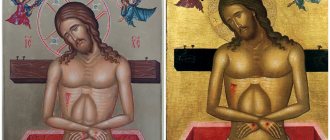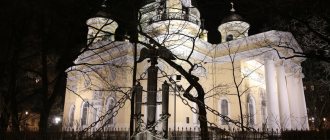Moscow, 07.24.2021, 05:22:45, editorial office of FTimes.ru, author Yulia Savelyeva.
Since ancient times, the number of Orthodox saints who are considered patrons of marriage includes Peter and Fevronia. Many people strive to come to Murom, where their relics are kept, to ask for protection and pray for the acquisition of family happiness. The union of Peter and Fevronius is a true example of pure love.
On July 14, the relics of the saints will be delivered to Moscow for the veneration of believers. City officials have outlined how the process will take place and where it will take place.
What to expect on Sunday in Moscow
On July 14, the relics of Peter and Fevronius will be brought to Moscow. This will be done so that believers who do not have the opportunity to visit Murom will also be able to venerate the relics of the patrons of the marriage.
It is known that the relics will stay in the capital for a week, the meeting will be led by the Patriarch of Moscow and All Rus' Kirill. Please note that in connection with the visit of clergy with the relics of Peter and Fevronia, the city authorities decided to close one of the exits of the Kropotkinskaya metro station.
You can venerate the relics in the Cathedral of Christ the Savior.
Comments
To the shrines in May: Top 5 pilgrimage routes in Moscow and the Moscow region
The shrines of Third Rome and its surroundings are important for every Orthodox person to visit, since this is where the heart of our Church is located
The May “long weekend” is always a reason for serious choice and reflection. Cottage or sofa? Sofa or cottage? Of course, there are those for whom it is not a serious problem to “rush for the weekend” to some azure (or not so azure) coast, but for the vast majority of my compatriots this is not even in their dreams. And yet, a change of scenery is very important for each of us, because proper rest without it is simply impossible.
Of course, there are also principled homebodies, and those for whom dacha affairs are so long-awaited that nothing can be exchanged for them. Here I want to address people who want not only to make a short tourist trip, but to combine it with benefit for the soul. No, we are not talking about pilgrimage in its traditional form: a kind of ancient Russian pilgrimage, when a person spent a very long time prayerfully preparing for the journey to the shrine, and then often traveled to it on foot with a knapsack on his back. And there is not a drop of irony here: such a journey, of course, has much more spiritual benefits than traveling by car, train or plane.
However, for a modern person, burdened with the worries of this century, such a pilgrimage is impossible. That is why we usually prefer “religious tourism” to it, often without even preparing for the Sacraments of Confession and Communion, so that, having venerated this or that shrine, we also take part in the service and partake of the Holy Mysteries of Christ. Most of us, arriving at a distant monastery, only have time to quickly venerate its revered shrine (relics and/or icons), take a few pictures with a mobile camera, post them on blogs and social networks, and then go home.
God forbid, there is not a grain of condemnation in my words, if only because from these people “I am the first.” And understanding the inferiority of such pilgrimage, I am sure that it also leaves a very important mark on the soul. And for some, I’m sure, it may well become the first step towards becoming a church member. After all, any touch to a shrine, devoid of blasphemy, cannot but bring spiritual benefit. Maybe not here and now, but at least over time.
In the next two materials, I will offer readers of Tsargrad 10 pilgrimage routes that are most convenient for residents of Moscow and the Moscow region, as well as our Northern, Imperial capital - St. Petersburg and the region still called Leningrad. There will be no more complex or multi-day trips here, because even a “long” weekend is not a multi-day vacation.
So, the first part is “TOP-5 pilgrimage routes in Moscow and the Moscow region”:
1. Holy Trinity Sergius Lavra
This is the main monastery of Russia, founded in the 14th century by one of the most revered Russian saints - St. Sergius of Radonezh . For seven centuries now, the Lavra has been one of the key symbols of Russian Orthodoxy. A place where thousands of pilgrims flock from all over the Orthodox world to venerate the numerous Lavra shrines, and first of all, the venerable relics of St. Sergius - an ascetic and man of prayer, a teacher of a host of Russian saints and a mentor of princes, it is no coincidence that he is called “Hegumen of the Russian Land.”
View of the Trinity-Sergius Lavra. Photo: www.globallookpress.com
Thus, it was Sergius of Radonezh who blessed Grand Duke Dimitri Donskoy for the Battle of Kulikovo, which became a key point in all Russian history. With his prayers and instructions, St. Sergius of Radonezh did everything so that our country would gain political sovereignty. Based on Byzantine state traditions and the unfading spiritual ideal of Holy Rus'.
Not all pilgrims know how many shrines the Lavra of St. Sergius contains. Any believer can venerate some of them in the Lavra Serapion Chamber, the resting place of another great saint of God - St. Serapion, Archbishop of Novgorod. Every believer who has visited the Trinity-Sergius Lavra should also visit the Serapion Chamber, where, in addition to the burial place of St. Serapion of Novgorod, many of the greatest Christian shrines are also kept. Including particles of the Robe of the Most Holy Theotokos and the relics of St. Apostle Andrew the First-Called.
Also, anyone interested in the history of the Russian Orthodox Church is strongly recommended to visit the Church-Archaeological Office (CAC) of the Moscow Theological Academy, which is also located within the Lavra walls. Relatively recently, this museum collection was reconstructed and now presents a modern exhibition that clearly tells about various pages of Russian church history.
get to the Trinity-Sergius Lavra :
- By train from the Yaroslavsky station in Moscow (Komsomolskaya metro station) to the station. Sergiev Posad or by electric train to the station. Alexandrov or Balakirevo, which also stop in Sergiev Posad. Travel time is one and a half hours.
- Take bus No. 388 from the VDNH metro station to the city of Sergiev Posad, in the very center of which the Lavra is located. Buses depart at intervals of 10-15 minutes. Travel time without traffic jams is a little over an hour.
- By personal vehicle : Yaroslavskoe highway (M8 highway), at the 46th kilometer turn to Sergiev Posad. The central street - Red Army Avenue - will lead you to the Lavra.
2. Vysoko-Petrovsky Monastery
One of the most famous and magnificent Russian monasteries, whose history goes back more than seven centuries. And most importantly, it is the place from which the new historical reality of Holy Rus' came: the role of Moscow as the heir of Constantinople. The Mother See of the City, which will take on the great mission of the “Third Rome”, keeping the world from the reign of the Antichrist.
Let us remind you that according to many church prophecies, the Antichrist will reign only when there is no one left to keep the world from iniquities, in Greek - “Katekhon”. Saint John Chrysostom argued that in his time the “Restrainer” was the Roman Empire, which even in pre-Christian times prevented world evil and anarchy by the power of state law. Russia became the heir to the Second Rome - Constantinople and the entire Eastern Roman Empire - Byzantium. Thus, at the beginning of the 16th century , Elder Philotheus of the Spaso-Eleazarov Monastery wrote:
Two Romes have fallen, but the Third stands, and there will not be a fourth..."
Providentially, one of the sources of Moscow as the Third Rome originates in Western Rus' - in Volyn. It was here, in the middle of the 13th century, that a baby was born into a pious Orthodox family, who half a century later was destined to become the first Moscow High Hierarch - Metropolitan Peter. The spiritual father of the emerging Third Rome. In 1308 , Abbot Peter became Metropolitan of Kiev and All Russia. In those years, there was a struggle for the grand ducal throne in the Russian lands, and the saint acted as a conciliator in it, but in the end he sided with Prince Yuri of Moscow. In 1315, Metropolitan Peter first arrived in Moscow, where he founded the Vysoko-Petrovsky Monastery and where he eventually moved permanently.
On the territory of the Vysoko-Petrovsky Monastery. Photo: www.globallookpress.com
In a word, it was here, in the Vysoko-Petrovsky Monastery, that Moscow was born spiritually, and it was from here that in the 14th century the unification of Rus' began, its deliverance from civil strife and liberation from the Horde yoke. And the role of St. Peter in this great work was fundamental, which has not lost its relevance today. Today, the honest relics of St. Peter rest in the very heart of Third Rome - in the Patriarchal Assumption Cathedral of the Moscow Kremlin. But every Orthodox Christian can worship him both in the Kremlin and in the Vysoko-Petrovsky Monastery founded by this great Russian saint. Bow down and ask for his prayers for the unity of the Russian Land and the entire Orthodox world.
Getting to the Vysoko-Petrovsky Monastery is very easy; it is located in the center of Moscow, at the address: Petrovka Street, building 28/2. The nearest metro stations are Trubnaya, Chekhovskaya, Pushkinskaya and Tverskaya.
3. Joseph-Volotsky stauropegial monastery
The greatest shrine of the Western Moscow region. The history of this monastery goes back more than half a millennium: the monastery was founded in 1479 from the Nativity of Christ by the Monk Joseph of Volotsky . An ascetic and educator who determined the future of Russia and the Russian Church for centuries. To the saints, whose venerable relics still rest today in the monastery he created.
Ascetic severity combined with mercy towards others became the basis of the teachings of St. Joseph, whose prayers and teachings allowed the Muscovite kingdom to overcome the turmoil associated with the spread of the Judaizer heresy in Rus', which in its essence was an attempt to combine Orthodoxy, Judaism and Protestantism. This was extremely beneficial to the West in its business of weakening the rapidly strengthening Muscovite Rus'. In his treatise “The Enlightener,” the Monk Joseph of Volotsky harshly castigated apostates. But at the same time, he found the warmest words to console repentant sinners. And today his testaments best show that real Christianity is not liberal humanism. And true love for one’s neighbors does not exclude the fight against the enemies of Russia and Orthodoxy.
The Joseph-Volotsk monastery also became famous for its many shrines. Among them is the Volokolamsk image of the Blessed Virgin Mary, which was delivered to the monastery of St. Joseph of Volotsky from Zvenigorod in March 1572 , on the 2nd week of Lent. A decade and a half later, the gate church of the southern gate of the Joseph-Volotsky Monastery was dedicated to the Volokolamsk image. Since then, the icon has been considered miraculous; many miracles and healings have occurred through prayers before it. But they especially prayed to the Most Holy Lady for intercession for the Russian Land.
Joseph-Volotsky stauropegial monastery. Photo: www.globallookpress.com
An ancient copy of this icon is now in the collection of the Central Museum of Ancient Russian Culture and Art named after Andrei Rublev in Moscow, but relatively recently it was recreated in its former splendor for the monastery, having already proven itself to be miraculous. And now, in the Joseph-Volotsk monastery, every Orthodox Christian can venerate not only the holy relics of its great founder, but also this miraculous icon, which is revered no less than its ancient copy.
Getting to the monastery from Moscow is somewhat more difficult than to other shrines in Moscow and the Moscow region, and therefore such a significant monastery is located somewhat away from popular pilgrimage routes.
- By car : along the Novo-Rizhskoye Highway, at the 98th kilometer of which you need to turn right towards Chismena station. Further through the railway crossing 22 km to the intersection. On it turn left for another 2.3 km to the intersection in Teryaevo. Here turn right and about 1 km more to the monastery, turn towards the village of Spirovo to the parking lot. Starting from the Novo-Rizhskoye Highway, at every intersection there are signs to the “St. Joseph-Volotsky Monastery”.
- By public transport : from the Rizhsky railway station in Moscow by train to the station. Chismena and Art. Volokolamsk From Tushinskaya metro station, take a bus to the city of Volokolamsk, then take a bus to the village of Teryaevo. Then walk about a kilometer.
4. Savvino-Storozhevsky Monastery
The main shrine of ancient Zvenigorod, the same age as the Russian capital, the Savvino-Storozhevskaya monastery was founded in 1398 from the Nativity of Christ by the Monk Savva Storozhevsky , one of the favorite students of Sergius of Radonezh and confessor of Prince Yuri of Zvenigorod. From the moment of its foundation, this monastery became the court abode of the Zvenigorod princes, and then a favorite place of the Russian tsars. Savva Storozhevsky repeatedly appeared in his monastery and its environs. Thus, in the 17th century , the monk saved Tsar Alexei Mikhailovich while hunting from a bear, and in 1812 , he saved the monastery from destruction by Napoleonic troops, appearing to the French commander Eugene Beauharnais, Napoleon’s stepson.
The Monk Savva did not leave his monastery even during the years of atheistic persecution, saving it from complete ruin. And in recent decades, the Savvino-Storozhevsky Monastery has been restored to almost its original splendor. However, no less difficult a task than the revival of monastic life within the walls of the monastery was the return to believers of the memory of its holy founder.
In the Savvino-Storozhevsky Monastery. Photo: www.globallookpress.com
Truly titanic efforts of the abbot and brethren of the Savvino-Storozhevsk monastery after the return in 1998 to these holy walls of its main shrine - the honest relics of the Monk Savva, his veneration was revived. And today every believer can come to the monastery of St. Sava to pray within its holy walls and venerate the relics of the founder of this wondrous shrine.
Directions:
1) By electric train : from the Belorussky railway station to the Zvenigorod station, then by bus No. 23 or No. 51 to the Monastyr stop;
2) By bus : from the Kuntsevskaya metro station to the city of Zvenigorod, then by bus No. 23 or No. 51 to the Monastyr stop;
3) By road : along the Novorizhskoe highway about 30 kilometers from the Moscow Ring Road to the interchange for Zvenigorod. Further, along the “concrete ring” another 10 kilometers to Zvenigorod. In Zvenigorod, opposite the Zvezda sports complex, turn right onto Moskovskaya Street, drive along it to the end (T-shaped intersection), turn right and then along the Moskva River for about 5 more kilometers until the first traffic light and the sign “Savvino-Storozhevsky Monastery” "
5. Resurrection New Jerusalem Monastery
One of the most unusual Russian monastic monasteries. A place that most clearly reflects the Ecumenical character of Russian Orthodoxy. Actually, when in 1656 the Primate of the Russian Church, Moscow Patriarch Nikon, founded this monastery, he set exactly this task - to create an exact reproduction of the Jerusalem Church of the Resurrection of the Lord (Cathedral of the Holy Sepulcher) in the Moscow region.
New Jerusalem Monastery. Photo: Vladimir Smirnov/TASS
On the one hand, the Patriarch wanted Russian pilgrims to be able, without moving away from their native places, to contemplate the places of the Passion of the Lord, the Crucifixion and Resurrection of Christ. And on the other hand, to show that the Russian Church is the Universal Church, and in our New Jerusalem there will subsequently be places for the Primates of all Local Churches, and accordingly the Moscow Patriarchate will become first among equals. In those distant years, when almost all Orthodox nations were under Muslim rule, it was expected that the Russian Tsar would lead their liberation. The latter was not destined to come true in those years, but the monastery was erected, truly revealing to the whole world the sovereign power of the Russian State and the spiritual greatness of the Russian Church.
During the Soviet years, the New Jerusalem Monastery was seriously damaged, but in recent years, thanks to the joint cooperation of the state and the Church, this shrine near Moscow has been restored to its former splendor. And today it again receives many pilgrims from all over the Orthodox world.
address : Moscow region, Istra, Sovetskaya str., 2.
get there by car along the Volokolamsk or Novorizhskoe highway (about 45 km from the Moscow Ring Road), through the city of Istra. By public transport - by electric trains in the Riga direction to the Istra or Novo-Ierusalimskaya stations, then by bus to the Monastyr stop or on foot for about 20 minutes. From Moscow by bus No. 372 from the Tushinskaya metro station to the Pochta stop, then transfer to a bus to the Monastyr stop.
And in conclusion, I would traditionally like to wish everyone who decides on this little journey a Guardian Angel on the road! I hope this trip will be memorable and, most importantly, spiritually beneficial for you.
In what matters can you ask for help from Spiridon of Trimifuntsky
The Miracle Worker helps:
- from troubles and illnesses;
- cope with life's difficulties;
- in simple everyday affairs, in the house;
- at work;
- in improving material well-being;
- in purchasing housing;
- in case of crop failure.
You can only approach the saint with a pure soul and thoughts. They pray to him for healing from illnesses and ailments, for an improvement in their financial situation, for the successful completion of a task, and for overcoming difficult life situations. Before you come and venerate the relics of Saint Spyridon of Trimifunt in Moscow, read prayers to him.

